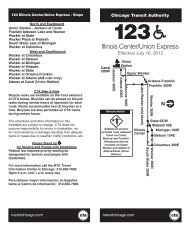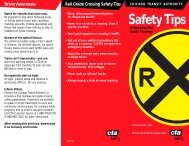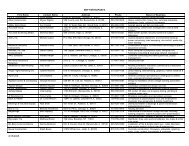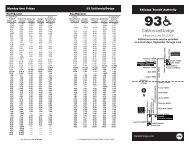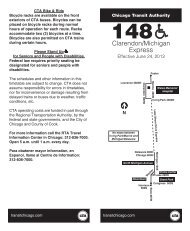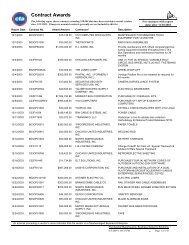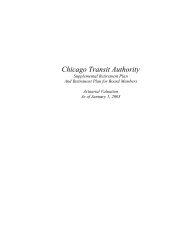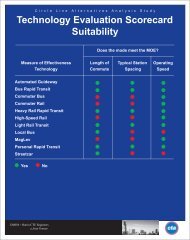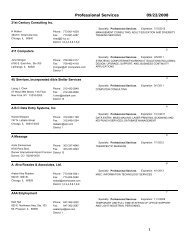Table Of Contents - Chicago Transit Authority
Table Of Contents - Chicago Transit Authority
Table Of Contents - Chicago Transit Authority
You also want an ePaper? Increase the reach of your titles
YUMPU automatically turns print PDFs into web optimized ePapers that Google loves.
CTA Express Airport Train Service Business Plan<br />
staffing). This model would require work rule flexibility in the area of staffing selections and disciplinary<br />
actions would be required to ensure consistently high service levels.<br />
The recommended alternative to the CTA Enterprise model that utilizes more private sector involvement<br />
is the Private Model with CTA Services. Here, the management company develops the project, operates<br />
the system, and buys certain services from CTA’s transit services departments; such as train operations<br />
and rail car maintenance. It may be noted that CTA’s rail employee union has agreed to CTA’s<br />
contracting of premium or specialty rail services. However, CTA may not outsource train operation,<br />
repair, or switching under the current agreement.<br />
5.3 IMPLEMENTATION PLAN<br />
The following summarizes the recommendation for key steps in the implementation of the airport train<br />
service from the 108 State Street Station to Midway and O’Hare airports.<br />
1. Focus on providing Direct Service with rehabilitated CTA railcars customized to provide comfort and<br />
amenities for air travelers running closed door service at current Blue and Orange line running times.<br />
Rationale: CTA’s agreement with The Mills Corporation stipulates that CTA must provide airport<br />
service when the 108 N. State Street station opens in 2008. The Express Service would<br />
not be ready in time for the opening; however, a Direct Service can be initiated by that<br />
time.<br />
2. Contract with the private sector for (1) a long-term Direct Service management contract (referred to<br />
above as the Private Model with CTA Services structure), (2) finish upgrades to the three stations,<br />
and (3) refurbishment of a fleet of 30 cars. The concession agreement would include all customer<br />
service operations related to the service including customer assistance, reservations, telephone<br />
system, information technology, sales, marketing, fare collection, and car cleanliness.<br />
Rationale: Private sector players can provide management, marketing, and development expertise<br />
to optimize revenues and service levels. Additionally, serving as the customer interface<br />
would further differentiate the airport service from CTA’s rail offerings. CTA procurement<br />
should be structured in a flexible manner to allow for evolution to the full Express<br />
Service, including the delivery of the infrastructure.<br />
3. Begin immediately with preparation of specifications for rail car systems and performance<br />
specifications for car interiors. Cars would receive an interior overhaul to add new seating, baggage<br />
racks, and other premium customer amenities before they would go into service in 2008.<br />
Outsourcing of the rehabilitation of the rail cars to be used for the Direct Service is necessary given<br />
the tight timeframe to the desired start-up of the service, as well as the need to have significant<br />
design expertise involved to achieve the desired premium results.<br />
Ideally, the service would run with 15 minute headways. However, headways may need to be longer<br />
at first if all 30 cars are not available at the time of the station opening. For service every 30<br />
minutes, approximately six sets of trains would be necessary instead of 12.<br />
Once service is up and running, cars would begin to be cycled through a mechanical overhaul<br />
process. A certain number of cars would be removed from service to receive the overhaul while the<br />
43





